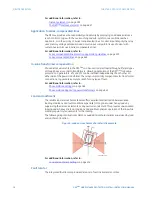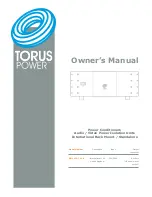
CHAPTER 1: GETTING STARTED
INTRODUCTION TO THE UR
Plus
-SERIES
D90
PLUS
LINE DISTANCE PROTECTION SYSTEM – INSTRUCTION MANUAL
3
The D90
Plus
is the sub-cycle distance protection and advanced automation controller for
the UR
Plus
-series platform.
Hardware architecture
The D90
Plus
is a microprocessor-based device. It has a modular design consisting of a
chassis containing discrete modules that interface over a common bus. Each module is
dedicated to a specific purpose. Several of the modules are required for basic operation of
the device, while others are optional.
The power supply module receives AC or DC power from an external supply and produces
conditioned 12 V DC power for all of the modules in the chassis. The power supply also
generates 48 V DC power for external contact wetting. The output contact indicating a
critical failure of the unit also resides on this module.
The AC module measures AC currents and voltages derived from CTs and VTs. These
signals are sampled and digitized and sent over the D90
Plus
bus to the CPU module for
further processing. A version is available that accepts nominal 5 A current and another
that accepts nominal 1 A current.
Input and output modules monitor digital (on and off) signals from external devices (field
contacts or other IEDs), control external devices such as breakers, and send digital signals
to other devices. Input and output modules are subdivided into protection inputs and
outputs and automation inputs and outputs, with several flavors of each type.
The CPU module contains the firmware for the D90
Plus
. The firmware contains the
algorithms required for the various functions provided by the device. The CPU receives
analog and digital data from the AC and input/output modules. The data is processed by
the CPU and resulting control actions are sent back to the input-output modules. The CPU
has one rear Ethernet port that is used for configuration and record retrieval and one rear
RS485 port supporting the Modbus and DNP protocols. The CPU also contains the IRIG-B
port required for clock synchronization.
The communications module is required for communicating with external devices over
Ethernet using the IEC 61850, DNP 3.0, or IEC60870-5-104 protocols. This module is also
required for peer-to-peer GSSE/GOOSE messaging. This module contains its own
microprocessor which is dedicated to handling communications tasks. It also contains two
redundant Ethernet ports. Each port supports 100Base-FX over multi-mode fiber and 10/
100Base-TX over twisted pair, with auto-negotiation. These ports may additionally be
configured for single IP or dual IP redundancy.
NOTE
NOTE:
The D90
Plus
requires one power supply module, one CPU module, one AC module, and at
least one protection input/output module. Communications modules are optional.
The front panel interface consists of an annunciator display, a main display, and an
EnerVista USB port. The annunciator display collects alarm indications from the
D90
Plus
internal functions and presents them using a standard annunciator format. Alarms
and their corresponding messages are entirely user-configurable. The main display allows
the user to view metering data collected by the D90
Plus
. It also provides access to the
control functions via dedicated control pushbuttons. The USB port allows the user to
interface with the D90
Plus
using the EnerVista software running on a portable PC. The
D90
Plus
operates independently from the front panel interface.














































